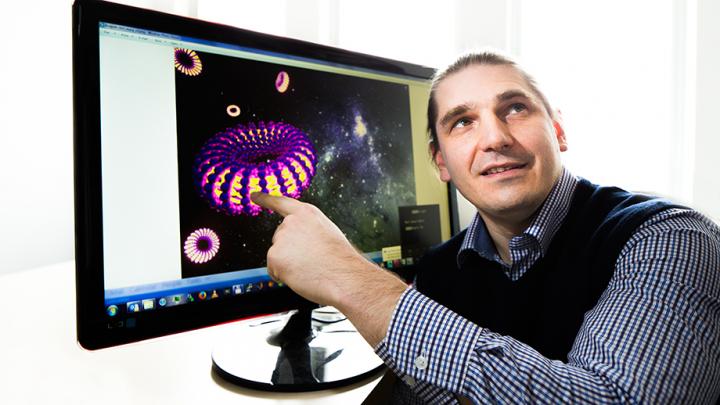New theory leads to radiationless revolution

Dr. Miroshnichenko with his visualization of anapoles as dark matter. Credit: Stuart Hay, ANU
Physicists have found a radical new way confine electromagnetic energy without it leaking away, akin to throwing a pebble into a pond with no splash.
The theory could have broad ranging applications from explaining dark matter to combating energy losses in future technologies.
However, it appears to contradict a fundamental tenet of electrodynamics, that accelerated charges create electromagnetic radiation, said lead researcher Dr Andrey Miroshnichenko from The Australian National University (ANU).
“This problem has puzzled many people. It took us a year to get this concept clear in our heads,” said Dr Miroshnichenko, from the ANU Research School of Physics and Engineering.
The fundamental new theory could be used in quantum computers, lead to new laser technology and may even hold the key to understanding how matter itself hangs together.
“Ever since the beginning of quantum mechanics people have been looking for a configuration which could explain the stability of atoms and why orbiting electrons do not radiate,” Dr Miroshnichenko said.
The absence of radiation is the result of the current being divided between two different components, a conventional electric dipole and a toroidal dipole (associated with poloidal current configuration), which produce identical fields at a distance.
If these two configurations are out of phase then the radiation will be cancelled out, even though the electromagnetic fields are non-zero in the area close to the currents.
Dr Miroshnichenko, in collaboration with colleagues from Germany and Singapore, successfully tested his new theory with a single silicon nanodiscs between 160 and 310 nanometres in diameter and 50 nanometres high, which he was able to make effectively invisible by cancelling the disc's scattering of visible light.
This type of excitation is known as an anapole (from the Greek, 'without poles').
Dr Miroshnichenko's insight came while trying to reconcile differences between two different mathematical descriptions of radiation; one based on Cartesian multipoles and the other on vector spherical harmonics used in a Mie basis set.
“The two gave different answers, and they shouldn't. Eventually we realised the Cartesian description was missing the toroidal components,” Dr Miroshnichenko said.
“We realised that these toroidal components were not just a correction, they could be a very significant factor.”
Dr Miroshnichenko said the confined energy of anapoles could be important in the development of tiny lasers on the surface of materials, called spasers, and also in the creation of efficient X-ray lasers by high-order harmonic generation.
Media Contact
All latest news from the category: Physics and Astronomy
This area deals with the fundamental laws and building blocks of nature and how they interact, the properties and the behavior of matter, and research into space and time and their structures.
innovations-report provides in-depth reports and articles on subjects such as astrophysics, laser technologies, nuclear, quantum, particle and solid-state physics, nanotechnologies, planetary research and findings (Mars, Venus) and developments related to the Hubble Telescope.
Newest articles

Webb captures top of iconic horsehead nebula in unprecedented detail
NASA’s James Webb Space Telescope has captured the sharpest infrared images to date of a zoomed-in portion of one of the most distinctive objects in our skies, the Horsehead Nebula….

Cost-effective, high-capacity, and cyclable lithium-ion battery cathodes
Charge-recharge cycling of lithium-superrich iron oxide, a cost-effective and high-capacity cathode for new-generation lithium-ion batteries, can be greatly improved by doping with readily available mineral elements. The energy capacity and…

Novel genetic plant regeneration approach
…without the application of phytohormones. Researchers develop a novel plant regeneration approach by modulating the expression of genes that control plant cell differentiation. For ages now, plants have been the…





















